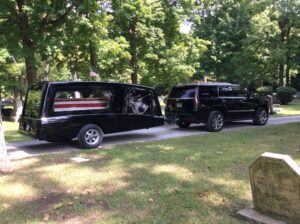Financial strategies with capital investments

The Coasson Funeral Coach
A couple of weeks ago Funeral Director Daily did a couple of articles dealing with working on an operating budget for funeral homes. We looked at both the income and the expense sides and told you of how we budgeted over the years for profit. . . .even if our call numbers came in lower than expected.
Over the years I’ve often thought and have come to believe that there are three main objectives in a triangle that build a very profitable business. The first is building your brand so that you have business. . . . without business coming to you, all the financial decisions you make are moot. . . .because with no business. . .there will be no profits.
The other two points of that triangle that build a profitable business are the ideas of enhancing existing revenues and containing existing costs. And, while that can be done with annual operating budgets, capital investment budgets are where one can really see some cost containment.
I recently saw a new product that reminded me of some capital expenditures that I was able to reduce by some strategic developments. First of all, the product that I recently discovered was the Coasson Funeral Coach, a name derived out of the names “coach” and “caisson”. You can learn about the company here.
The capital investment strategy where I saved a lot of money over the years was in how we handled our rolling stock or fleet of vehicles. When I first started, our funeral home needed to have 2 funeral coaches, some other utility vehicles for flowers, and limousines for lead cars with the clergy, pallbearers, etc. The funeral coaches were well used as we used them for first calls as well as funerals.
Sometime in the 1990’s when vans were becoming more popular I started wondering about the possibilities of getting vans for removals and over the road distance transportation of the deceased. The thought process is that we would very much limit the miles put on the funeral coaches and possibly be able to stretch their use. I also looked at the practicality and cost of keeping limousines in our community that was not known for limousines outside of funeral home use.
I put a plan together calling for us to get rid of our limousines, purchase used but good conditioned hearses that would only be used in funeral corteges, and purchase several matching vans that could be used for first calls, flowers, pallbearers, and clergy dependent on how we arranged the seating.
I was really nervous about this potential change which would eliminate the costs of new hearses and limousines, but might come with a reputational risk that we were “lowering our quality”. I was pretty certain that the hearses did not have to be the calendar year model, but they did have to be late model looking and in good shape. To that end, I was able to work out arrangements to buy used models from a livery service every couple of years. They had pretty high mileage, but had been kept up very well, and we only put church to cemetery miles on them so they lasted and presented us in a “high quality” mode.

The Coasson Funeral Coach
And, I worried about the image of removal vans as compared to funeral coaches when we showed up on a first call. However, I was somewhat at ease when I asked around and television images of “coroner vans” was what people seemed to expect. Those who had not had a death, did not know that we came in a funeral coach. . . . . Quite frankly, I found out in my investigation that vans is how the consumer expected to see us arrive.
To make a long story short, we moved ahead with our strategic rolling stock capital investment plan and it proved profitable. We ended up saving lots of dollars every year and I don’t think that, consumer related, our brand dipped in quality perception at all. It was this episode where I became convinced that the consumer is less resistant to change in our profession than we are.
So, the point of this article is not to tell you what to have in rolling stock. . . each operator has to make that decision. However, most funeral homes are seeing a decline in casketed burials requiring a funeral coach. While the fixed cost of that funeral coach remains the same, it it gets less use, then the “cost per use” in increasing.
Whenever you see that “cost per use” increasing as in the case that new funeral coaches cost more and you use them less, then I think it is time to look at the strategic alternatives available. . . . whether that is different vehicles, livery services, or the Coasson.
More news from the world of Death Care:
- Three little know ASX dividend shares offering big income. The Motley Fool – Australia
- Dignity (plc) loses two long-standing board members as it works on new strategy. ProActive – Great Britain
- Insider buying: The Carriage Services founder just bought 2.3% more shares. Simply Wall Street
Enter your e-mail below to join the 1,803 others who receive Funeral Director Daily articles daily:





















Anyone that’s not seriously considering a Coasson is kidding themselves. With cremation rate on the rise and profit margin shrinking. Its time for funeral professionals to get there head out of the sand so to speak and look to the future.
Thank you for your comments.